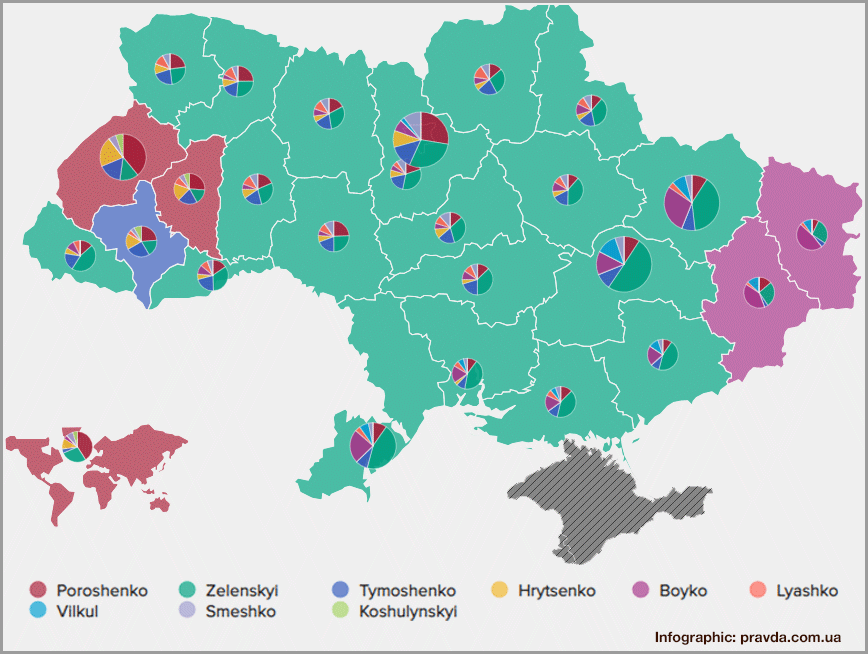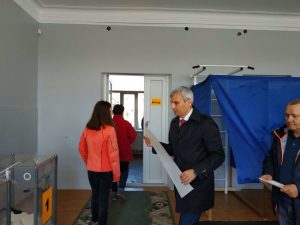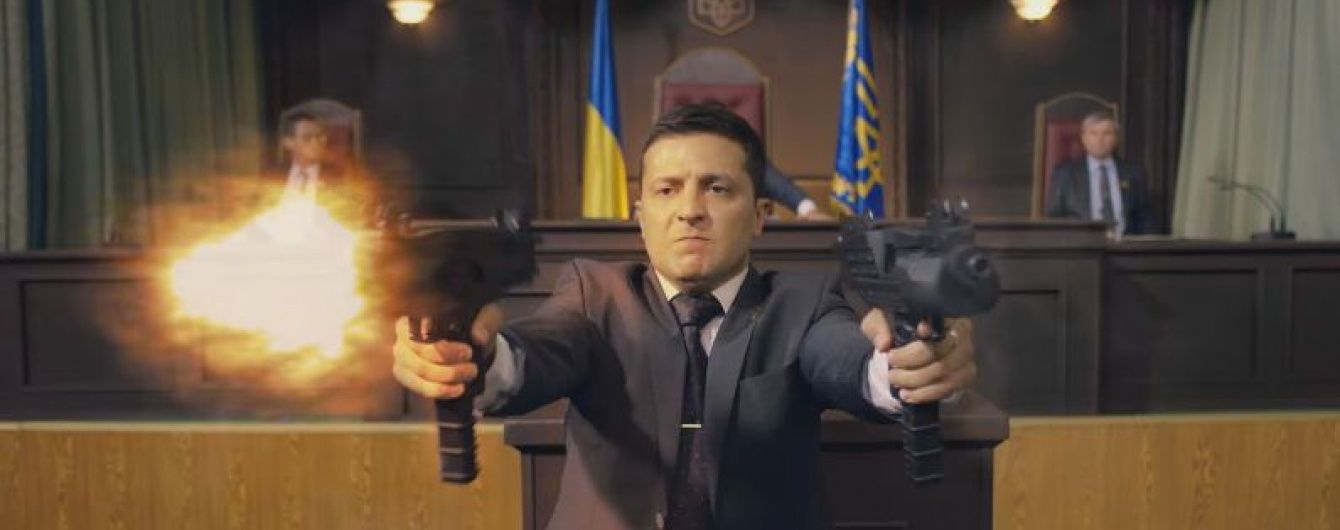The results of the first round of the Ukrainian 2019 presidential elections show that the surveys were pretty accurate. Zelenskyy wins the first round with more than 30.2%. Poroshenko receives 15.9%. Former Prime Minister Yulia Tymoshenko is trailing in third place with 13.4%.
Nobody received more than 50%, this means that Ukraine will vote again in the run-off, where Zelenskyy and Poroshenko will compete. According to the law, the repeated voting will take place three weeks after the day of the first round, on 28 April.
Here is my subjective opinion on four key points the first round showed:
1. TV promotion works
Volodymyr Zelenskyy is a TV celebrity who has been promoted for years by the second most popular Ukrainian channel “1+1” owned by oligarch Kolomoiskyi. Zelenskyy had multiple comedy shows on 1+1, as well as co-hosted programs with various Russian comedians.

In November 2015, the TV series “Servant of the People” premiered on 1+1, where Zelenskyy plays a part of a history teacher, Russian-speaking Ukrainian Vasyl Holoborodko who by chance of fate becomes president. Its second season came out in 2017, and the third started in late March 2019, just several days before the real presidential elections, in which Zelenskyy had participated. This TV series can be called the longest political commercial ever, since many people all-around Ukraine voted for a positive TV character having no idea what the real Zelenskyy is going to do as president – he hasn’t still voiced who the members of his team will be and what policies he is going to pursue.


On the other hand, Ukrainian media have been demonizing incumbent President Petro Poroshenko starting from 2014. It has been normal for Ukrainian media to skip reporting on any successes the state has achieved or to downplay their importance, focusing on any negative events, as well as to blame Poroshenko personally of any failures, no matter real or fake. And it unfolded amid the disastrous information policy of the presidential administration and multiple dubious appointments.
In fact, over the five years in which Ukraine succeeded in not just surviving as a state, but also in conducting many ground-breaking reforms. Meanwhile, the media coverage of the presidential activities typically consisted of the messages that Poroshenko doesn’t do something or does something wrong or covers corruption or himself embezzles or even is worse than oustd ex-president Yanukovych. In the background of this information tendencies of the Ukrainian media, Russia didn’t stop pushing false narratives of Ukraine as a failed state with incompetent leadership.
Poroshenko says Russia did not want him in the second round. Kyiv, 31 March 2019. Video: RFE/RL
For example, the latest case in the row was linking Poroshenko’s name to suspected embezzlement in Ukrainian defense industry concern Ukroboronprom by journalists of bihus.info without any real connection of Poroshenko to the suspected corruption schemes. Ex-PM Tymoshenko, one of Poroshenko’s major rivals at the election, tried to start the impeachment procedure, and the far right party “National Corps” whose candidate doesn’t participate in the election activated and started spinning the topic, attempting to stick the label of “marauder” on Poroshenko.
Plus, Poroshenko made the revival of the Ukrainian army of the cornerstones of his campaign (the campaign’s slogan is “Army, Faith, Language”). Meanwhile, not just the very real Russian threat but also the ongoing war itself have almost disappeared from the Ukrainian news, making many Ukrainians believe that Ukraine is already at peace.
Of course, such a media background made Zelenskyy appear much better than the incumbent President for an average voter. As well, the fictional TV character stole the spotlight from the real-life Zelenskyy, a crony of fugitive oligarch Ihor Kolomoyskyi, who himself has business connections to Russia, uses offshore schemes and ridiculed Ukraine as a country and Ukrainians as a nation many times in his sketches.
Almost the same had happened back in 2010 to another pro-Western President Viktor Yushchenko, whose popularity was totally destroyed in a few years by domestic media which led to the subsequent presidency of Viktor Yanukovych.
2. Tymoshenko has lost, can she return?

Former Prime Minister Yuliya Tymoshenko came third in the 2019 Ukrainian presidential election with about 13% of the vote share. In December 2018, just before Zelenskyy announced his bid for the presidency, she led in surveys with 12-14%. Five years ago, Tymoshenko finished the 2014 presidential run with almost the same 12.8%. This shows that her electorate is stable.
Can Tymoshenko become the head of state? Well, technically, she still has three possibilities.
Article 85 Paragraph 3 of the Law on the Elections of the President of Ukraine says that if one of two candidates included in the repeat vote ballot paper withdraws not later than 12 days prior to the repeat voting day, then the Central Electoral Commission should immediately replace such a candidate with the one “next by the number of votes received on the election day.”
This means that if Zelenskyy withdraws before 16 April, Tymoshenko will take his place in the run-off and can try to beat Poroshenko in the second round. Though if Zelenskyy will withdraw later, only Poroshenko will remain in the ballot, according to Paragraph 4 of the same Article.
Just as the results of the official exit polls emerged, Tymoshenko refused to accept them, claiming that her party had conducted their own survey in which she outruns Poroshenko with 20% against his 17%. Meanwhile, Poroshenko said that
“[the Ukrainians] have broken the Russian scenario for the first round, because [Russia] would certainly like to see not Poroshenko in the second round.”
The cited norm of the law and the mentioned statements of the politicians may shed light on possible agreements between Tymoshenko and Kolomoiskyi who is behind Zelenskyy and with whom Tymoshenko had reportedly met several times before the elections. They could have planned to have Zelenskyy and Tymoshenko in the run-off round and withdraw Zelenskyy days before the voting when only one candidate (read: Tymoshenko) would remain in the ballot paper.
At least, Poroshenko seems to believe that it was the scenario, alternatively, he could imply that Russia wanted to see Tymoshenko and it overt supporter Yurii Boyko.
There is another possibility for Tymoshenko to head Ukraine. Ukraine is a parliamentary-presidential republic, where the parliament, Verkhovna Rada, has more powers than the head of state, the president. Back in September 2018, Yuliya Tymoshenko presented her conception of a “new constitution of Ukraine.” Her project makes Ukraine a purely parliamentary republic, in which most presidential powers would be transferred to a chancellor appointed by the parliament. The President in this scheme plays a mere ceremonial, non-executive role.
If Tymoshenko’s plan was agreed between Tymoshenko and Kolomoiskyi, then we may witness an attempt of the “Servant of the People” party, existing only on paper for now but already having high ratings, to win the constitutional majority at the parliamentary elections in October 2019 with subsequent efforts to amend the Constitution in order to change Ukraine’s form of the government.
The third possibility for Tymoshenko to become the head of state is much more traditional – she can still wait five more years and run for the presidency once again in 2024. However, her popularity wanes year by year (she had 25% in the first round of the 2010 presidential elections against 12-13% in 2014 and 2019). Thus, this option is much more unlikely than replacing Zelenskyy in the run-off or attempting to break the existing government form and become a chancellor.
3. Nationalism not popular

The 2019 elections confirmed that far-right parties still have almost zero popularity in Ukraine. The only far-right candidate Ruslan Koshulynskyi (“Svoboda” party, also supported by the C14 nationalist group) gets only 1.6%.
In 2014 the results were similar. At first, Oleh Tiahnybok (from the far-right “Svoboda”) and Dmytro Yarosh (far-right “Right Sector”) failed at presidential elections with 1.2% and 0.7% respectively. Later that year, both right-wing parties didn’t pass the 5% threshold at the parliamentary elections, gaining only 4.7% and 1.8%. In single-member constituencies, the parties received only 8 seats in the 450-seat Verkhovna Rada. One more far-right parliamentarian not represented in Parliament was Andriy Biletskyi, who now leads his party “National Corps.”
The actual results of the free and unfettered expression of the Ukrainian citizens sharply contrast with the half-decade-long Russian propaganda campaign exploiting the narratives of the purported rise and growth of fascism and nationalism in Ukraine.
4. Yanukovych voters still vote for his party
The free parts of Luhansk and Donetsk oblasts showed just the same result as they showed at several previous elections. Both regions still vote for Yanukovych, or rather for his fellow party man. Yuriy Boiko leads in both regions with more than 40%. Openly pro-Russian Boiko is the leader of the parliamentary party “Opposition Bloc,” the largest fragment of Yanukovych’s Party of Regions which collapsed back in 2014 shortly after its leader was ousted by the Euromaidan revolution.
Both eastern-Ukrainian oblasts were the electoral “foothold” of Yanukovych and his party, and the latest voting shows that they remain as such. The war didn’t change anything in their political preferences.
Volodymyr Zelenskyy has a strong chance to become President at the run-off. However, we can’t say that Petro Poroshenko has no chances. Especially, if the incumbent President manages to consolidate the pro-Ukrainian electorate in the next three weeks.
Read also:
- Ukrainians once again are voting for someone they hope has a magic wand, Portnikov says
- Ukrainian 2019 presidential elections: Live updates
- “Ukraine will turn into a banana republic”: Ukrainian elections on Russian TV
- Ukraine-related narratives dominate Russian propaganda – disinformation watchdogs
- Do Ukraine’s right-wing extremist groups have a chance of derailing presidential elections?
- Two Ukrainian TV channels push Russian propaganda amid presidential election: report
- Three reasons why a comedian should not be president of Ukraine
- Pollsters say Zelenskyy leads in Ukraine’s presidential race. Bookies lean towards Poroshenko
- Oligarchic shadow of Ukraine’s 2019 elections
- Ukrainian prankers organize rent-a-mob rally in support of serial killer “presidential candidate”
- Is Tymoshenko a pro-Russian candidate? The facts, the fiction, and the mysteries
- Fifty shades of Ukrainian populism: Tymoshenko, Zelenskyy, and the Chiaroscuro principle






